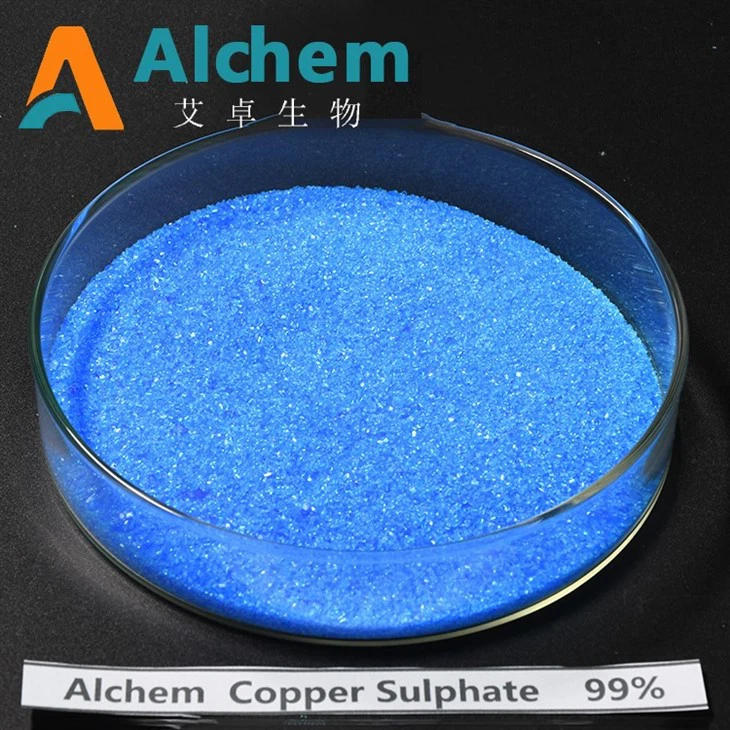As a supplier of Copper Sulphate Feed Grade, I've often been asked about how this product affects the taste of animal feed. In this blog, I'll delve into the scientific aspects of this question, exploring the role of copper sulphate in animal nutrition and its potential impact on feed palatability.
The Role of Copper Sulphate in Animal Nutrition
Copper is an essential trace element for animals, playing a crucial role in various physiological processes. It is involved in the formation of hemoglobin, the development of the nervous system, and the maintenance of a healthy immune system. Copper also acts as a co - factor for many enzymes, such as superoxide dismutase, which helps protect cells from oxidative damage.
Copper Sulphate Feed Grade is a common source of copper in animal feed. It is highly soluble in water, which makes it easily absorbed by animals. The recommended levels of copper in animal feed vary depending on the species, age, and production stage of the animals. For example, pigs require around 5 - 25 ppm of copper in their diet, while poultry may need 4 - 10 ppm.
Impact on Feed Taste
The taste of animal feed is a complex characteristic influenced by multiple factors, including the raw materials used, processing methods, and the presence of additives. When it comes to Copper Sulphate Feed Grade, its impact on taste can be both direct and indirect.
Direct Impact
Copper sulphate has a distinct metallic taste. In high concentrations, this metallic taste can be quite strong and may potentially reduce the palatability of the feed. Animals have taste receptors that can detect different flavors, and the metallic taste of copper sulphate might be perceived as unpleasant by some animals. However, the threshold at which animals can detect this taste and be deterred from eating the feed varies among species.
For instance, ruminants such as cows and sheep may be less sensitive to the metallic taste compared to monogastric animals like pigs and poultry. This is because ruminants have a more complex digestive system, and their taste perception may be different. Pigs, on the other hand, are known to be more sensitive to taste and texture, and a high - level addition of copper sulphate could potentially lead to reduced feed intake.
Indirect Impact
The indirect impact of copper sulphate on feed taste is related to its interaction with other components in the feed. Copper sulphate can react with certain substances in the feed, such as proteins and fats. These reactions can lead to the formation of new compounds, which may either enhance or deteriorate the taste of the feed.
For example, copper can catalyze the oxidation of fats in the feed. Oxidized fats have a rancid taste and odor, which can significantly reduce the palatability of the feed. This is particularly important in feeds that are high in fat content, such as those used for high - performance animals. On the other hand, copper sulphate can also interact with some amino acids in the feed, potentially altering the flavor profile in a way that may be more or less appealing to animals.
Managing the Taste Impact
As a supplier of Copper Sulphate Feed Grade, we understand the importance of ensuring that our product does not negatively affect the taste of animal feed. Here are some strategies that can be employed to manage the taste impact:
Optimal Dosage
Using the correct dosage of copper sulphate is crucial. By following the recommended levels based on the animal species and their nutritional requirements, we can provide the necessary copper without overwhelming the feed with a strong metallic taste. Our technical team can assist customers in determining the appropriate dosage for their specific feed formulations.
Coating Technologies
Another approach is to use coating technologies. Coating the copper sulphate particles can help mask the metallic taste and prevent direct contact with the taste receptors in the animal's mouth. There are various coating materials available, such as polymers and fats, which can be used to encapsulate the copper sulphate. This not only improves the palatability of the feed but also helps in the controlled release of copper in the animal's digestive tract.
Feed Formulation
Careful feed formulation is also essential. By selecting high - quality raw materials and balancing the composition of the feed, we can minimize the potential negative interactions between copper sulphate and other components. For example, adding antioxidants to the feed can prevent the oxidation of fats catalyzed by copper, thus maintaining the freshness and palatability of the feed.
Related Products
In addition to Copper Sulphate Feed Grade, we also offer other trace element feed additives, such as Zinc Sulphate Heptahydrate Feed Grade and Zinc Sulphate Monohydrate Feed Grade. These products play important roles in animal nutrition and can be used in combination with copper sulphate to provide a balanced diet for animals.
Conclusion
In conclusion, Copper Sulphate Feed Grade can have both direct and indirect impacts on the taste of animal feed. While its metallic taste can potentially reduce palatability, proper management through optimal dosage, coating technologies, and careful feed formulation can mitigate these effects. As a supplier, we are committed to providing high - quality Copper Sulphate Feed Grade and offering technical support to ensure that our customers can achieve the best results in animal nutrition.


If you are interested in learning more about our Copper Sulphate Feed Grade or other feed additives, please feel free to contact us for further discussion and procurement. We look forward to partnering with you to enhance the quality of your animal feed.
References
- National Research Council (NRC). (2012). Nutrient Requirements of Swine. 11th Edition.
- National Research Council (NRC). (1994). Nutrient Requirements of Poultry. 9th Edition.
- Spears, J. W. (2003). Mineral Tolerance of Animals. 2nd Edition.





